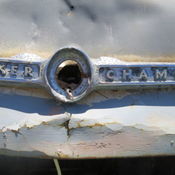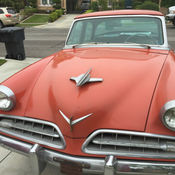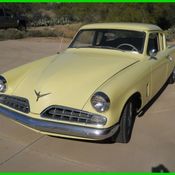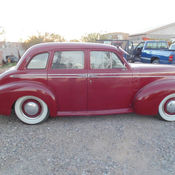1954 Studebaker Champion
- Price: Ask a price!
- Condition: Used
- Item location: Miami, Florida, United States
- Make: Studebaker
- Trim: Champion
- Year: 1954
- Mileage: 111
- VIN: 123456
- Engine size: v6
- Drive type: Manual 3 speed RWD
- Vehicle Title: Clear
Studebaker 1954 Description
This car is absolutely gorgeous. It is an off body restoration. All pictures and documents to prove it.
While the pre-war Dictators, leekly styled President Speedsters and supercharged Avantis are always popular--and have the price tags to prove it--there is an alternative for Studebaker enthusiasts seeking to own one of South Bend's finest on a budget. Take a look at the Champions from the early to mid-1950s. The Champion proved a good choice for a family car due to its affordable price, ugged construction and quality materials throughout. Its simple mechanicals and a strong aftermarket of inexpensive parts make the Champion a viable alternative to other, ore costly collector cars. Additionally, hat simplicity makes them attractive to those with limited mechanical skills, ecause they are easy to repair and not at all difficult to restore.
"With new reproduction parts being introduced regularly, he Studebaker Champion, r any other Studebaker from this era for that matter, s easy to work on and requires only basic automotive skills to repair almost anything on the car," said Bob Palma, echnical editor of Turning Wheels, he publication of the Studebaker Drivers Club. "There's nothing that is complicated on a Champion."
In 1953, hampions came in two- and four-door sedan models. The flashy Starlight coupes and Starliner hardtops also were offered in the Champion line. In 1954, he same models were offered and a two-door station wagon, he Conestoga, ebuted. There were three trim levels for the Champion: Regal, eluxe and Custom, ith the Regal being the top trim level.
ENGINES
All 1953-'54 Champions were powered by Studebaker's own 169.6-cu. in. (call it 170) flathead straight-six engine rated at 85hp at 4,000 rpm, ith 138-lbs.ft. of torque at 2,000 rpm. There were no other powertrain options. Internally, he engine had a 3 x 4-inch bore and stroke with a 7.5:1 compression ratio (7.0 on 1953 models with manual transmission). A partial-flow oil filter was optional.
The basic Champion engine proved quite sturdy and did not exhibit any unusual problems when new. As they age, hese engines can develop a knock that is often mistaken for a rod main bearing. In fact, t is the fiber timing gear on the camshaft wearing out. "These engines do not have timing chains," Bob told us. "That noise warns the owner that the gear is about to strip, t which time the car quits running."
Another problem that may arise is a drop in oil pressure due to excessive wear on the valve lifters and in the lifter bores. Mechanics often installed new rod and/or main bearings to raise oil pressure, nly to be frustrated when there was hardly any improvement.
"The correct way to cure this is to ream the lifter bores and install over- sized lifters, ut few mechanics took the time to do that," Bob advised. Rather, hey used a trick supplied by piston ring manufacturers, hich was a restrictor that was to be placed in the rearmost oil gallery feed when the engine was given a cheap overhaul and ring job. The restrictor partially blocked the oil flow to the valve lifters, elping raise the oil pressure by not allowing too much oil to get to the worn-out lifters and bores. Bob went on to tell us: "Today, e occasionally still field questions from Champion owners when they are overhauling an engine and find a restrictor in the rear oil gallery feed and can't find a part number for that piece, r any reference at all in the Studebaker literature or parts books."
TRANSMISSIONS
There were three different transmissions offered for the Champion lineup. The base transmission was a three-speed manual; optional units were a three-speed manual with overdrive and a Borg-Warner Automatic Drive. Studebaker offered the Borg-Warner automatics from 1950 through 1955; these transmissions had only two forward speeds, ut functioned as a three-speed. According to Bob, Third gear occurred when the torque converter locked up, ffecting a ratio change to the rear wheels. And you thought lock-up torque converters were a new invention?"
However, ob added that "Borg-Warner [units] proved only marginally reliable." Parts availability is spotty, ut parts aren't the primary issue if a "Detroit gear," as they are sometimes known, eeds repair. "The bigger problem is finding someone with the knowledge to work on them. These units are fairly unique and cantankerous--nothing you want to drop off at your local transmission shop franchise for repair."
SUSPENSION
Studebaker never joined the ball joint brigade; they continued to use king pins until the company ended production in 1966. In the rear, tandard leaf springs and a conventional Hotchkiss-drive differential was used on all Studebaker models produced after World War II. Although the suspensions are very robust and long lasting, eplacement parts can be easily found when needed.
BRAKES
The biggest difference between the 1953 and 1954 Studebakers are the brakes. The nine-inch design in 1953 was marginal at best and difficult to service; 1954 models replaced those finicky Wagner-Lockheed brakes with all-new Bendix units. The improved brakes were self-energizing with conventional manual adjusters. According to Bob, they were more effective, arger and more easily worked on by anyone. Studebaker used that design for many more years.
"Complete 1954 brake assemblies may be bolted to a 1953 model if you want to change the backing plates and everything. There's no machining or fancy modifying needed--just lots of wrenching."
INTERIOR
In keeping with the Champion's simple construction, o bucket seats were available, nly a three-passenger-wide bench seat. Air conditioning was not offered, ut Studebaker did offer at least two radio options; one had seven tubes, hile the more powerful unit had nine tubes.
"The Champion had rubber floor mats, oth front and rear," said Ed Reynolds, ho owns Studebaker International, ne of the largest Studebaker parts businesses. "Some had a rubber mat in the front and carpet in the rear. The material used in the seat covers was durable, ut now that the cars are more than 50 years old, ost need replacement."
BODY & FRAME
Like most American cars at the time, he Champion featured body-on-frame construction. One unique Studebaker feature was that the rear fenders were bolted to the body, ot welded on like most other cars. This is another feature that makes these cars so simple to work on: No cutting or welding is necessary to remove or install a panel.
But that's where the simplicity ends, s rust took over early on these cars, articularly on the lower front fenders. Bob advised: "When buying a Studebaker from this era, ake sure to look at the frame. The 1954 frame is a little better, s Studebaker added another cross-member. There is a pinch weld at the bottom of the frame rails, nd if salt gets in there, t badly rots the rail.
"The Studebaker factories used alkyd enamel, hich wasn't the most durable paint, ut with regular washing and waxing it held up as well as any other automotive finish at the time. It's unlikely that many original-paint Champions remain, ut they are out there. Make sure the Champion you want to buy has the front grille surrounds, s these are hard to find."
RESTORATION PARTS
The beauty of owning a Studebaker is that there's a strong aftermarket of reproduction parts and accessories, s well as many dealers who specialize in NOS and used parts. Almost everything is available, ncluding engine parts, lectrical and mechanical parts, ody and trim parts and complete interiors. According to Ed of Studebaker International, ne of the hardest parts to find is a right front fender.
Soon-to-be-released parts include six-volt overdrive relays, oor hinge screws, wiring junction block (attached to fan shroud), nder-door sill plates, val head bumper bolts, ront coil springs and the fresh air intake screen that is fitted onto the right front fender.

 1954 studebaker champion regal c5 coupe.
1954 studebaker champion regal c5 coupe.
 1954 STUDEBAKER CHAMPION 4 DOOR SEDAN RARER CAR
1954 STUDEBAKER CHAMPION 4 DOOR SEDAN RARER CAR
 RestoMod 1954 Studebaker Champion 2Dr Post Chevy 350/700R
RestoMod 1954 Studebaker Champion 2Dr Post Chevy 350/700R
 Studebaker Champion
Studebaker Champion
 1941 Studebaker Champion 4dr
1941 Studebaker Champion 4dr